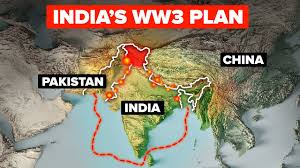The idea that a conflict between India and Pakistan could potentially escalate into World War 3 is rooted in several factors related to their history, military capabilities, and geopolitical positioning.
Let’s break it down:

https://snaphub.host/?attachment_id=1129
Nuclear Capabilities and Proximity
- Both India and Pakistan are nuclear-armed nations: This is arguably the most significant factor. Since both countries developed nuclear weapons, the prospect of a conventional war escalating into a nuclear conflict is a key concern.
- India has a much larger nuclear arsenal than Pakistan, but Pakistan has a tactical nuclear capability (smaller, battlefield-use nukes), which makes the threat of nuclear escalation more unpredictable and potentially rapid.
- Nuclear deterrence has often kept direct conflict limited, but in a high-stakes conflict, the risk of miscalculation or a failure of deterrence is a possibility.
Historical Context and Tensions
- Ongoing Hostility: India and Pakistan have a long history of conflict, primarily stemming from their partition in 1947, which led to widespread violence, the creation of two nations, and the disputed Kashmir region.
- They have fought three major wars (1947, 1965, and 1971), and numerous skirmishes have occurred over the years, especially over Kashmir.
- The Kashmir conflict remains one of the world’s most intractable territorial disputes, with both countries claiming the region as their own.
- Kashmir is a flashpoint: The region has seen both military skirmishes and diplomatic confrontations. In recent years, especially after India’s 2019 revocation of Article 370 (which gave Kashmir special status), tensions have been extremely high. Any military confrontation in Kashmir could have the potential to draw in other powers.
Involvement of Global Powers
- A conflict between India and Pakistan wouldn’t necessarily remain limited to the two countries. Both nations have key allies and global interests.
- India has close strategic ties with the United States, Russia, and various Western countries, including the European Union. The U.S. views India as a counterbalance to China’s rise in Asia.
- Pakistan, on the other hand, is closely allied with China and has a long history of military and strategic support from Saudi Arabia and other Gulf states.
- If a conflict broke out, these alliances could quickly make the situation more complicated and involve major powers. China‘s support for Pakistan and the U.S. or NATO’s potential backing of India could turn a regional conflict into a global one.
Potential Escalation and Global Response
- If fighting escalated to the point where either country used nuclear weapons, the global community would likely step in to prevent further escalation, but the consequences could still be catastrophic.
- A nuclear exchange between India and Pakistan could lead to massive loss of life, environmental devastation (through nuclear winter effects), and global economic disruptions.
- The UN, NATO, or regional powers could be forced to intervene to prevent an all-out nuclear war, but the initial stages of the conflict could still cause massive destabilization.
- There’s also the risk of proxy warfare: With both countries having significant regional influence, allies and smaller nations could get involved, further intensifying the conflict.

Global Economic and Strategic Interests
- Both India and Pakistan occupy strategic positions in South Asia, a region that is critical for global trade, shipping lanes, and energy supply routes.
- India, with its growing economy and influence, is increasingly seen as a global power and is a key player in global trade.
- Pakistan, while smaller in terms of economic power, holds importance in Central Asia and the Middle East, particularly with regards to access to the Arabian Sea and its role in Afghanistan.
- An all-out war between India and Pakistan could disrupt not just regional but global stability. This includes:
- Global markets (stocks, energy prices, trade routes).
- Security interests in the Middle East, Central Asia, and Southeast Asia.
Role of Cyber Warfare and Modern Technology
- In modern warfare, conflicts are not just fought with conventional or nuclear weapons but also in cyberspace.
- India and Pakistan have both conducted cyberattacks in the past. A cyberwarfare escalation could target critical infrastructure, further destabilizing the situation and complicating any diplomatic resolution.
- Social media and information warfare also play a significant role today. Both countries have significant online followings, and misinformation or propaganda could escalate nationalistic fervor, making it harder to de-escalate tensions.
Possible Triggers
- While India and Pakistan have been able to avoid large-scale wars in recent years, small triggers could escalate tensions.
- Terrorist attacks: Pakistan-based militant groups like Jaish-e-Mohammed and Lashkar-e-Taiba have carried out attacks in India, and Indian military operations in Pakistan-controlled areas (like Balakot airstrikes) have come dangerously close to sparking full-scale war.
- Border Skirmishes: The Line of Control (LoC) in Kashmir has seen frequent clashes. An incident here, especially with increasing nationalist sentiments on both sides, could easily spiral out of control.
Humanitarian Impact
- The sheer human cost of a conflict between two nuclear powers would be catastrophic, especially given the large populations involved (over 1.7 billion people in total). Even a limited conflict could cause widespread refugee crises, food shortages, and mass casualties.
That said, if conflict were to escalate uncontrollably, especially with nuclear weapons or a proxy war, global powers might be forced to intervene to prevent further destruction. World War 3 isn’t necessarily the direct outcome, but it could lead to significant global instability.


